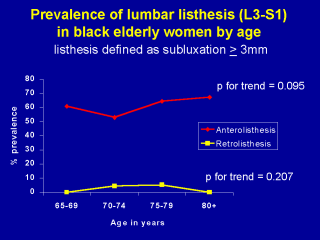 |
For these ladies also, I looked at vertebral listhesis and I
donít know if you remember the scale on the other one but anterolisthesis here is varied
between 60. Really there is not much trend for age but it varies from about 55 up to about
62%. Remember the figures for the white women were about half that. Retrolisthesis is a
very, very low percent. So that basically we are bearing out what orthopedic surgery has
said in some of its clinical studies that blacks, at least black women, have about twice
as much anterolisthesis, vertebral listhesis, as do white women. They also have less
retrolisthesis.
What does the leg pain do to these black ladies in SOF? Well as you might expect, with
everything else Iíve shown you, we just have a little bit differently here. On comparing
the people with LBP only and the people with the back pain and leg pain. So the people
with leg pain are five times more likely to report problems moving, causing changes in
mood, problems sleeping, problems working, problems with recreation and with general
enjoyment of life and I have a lot of other data on this. But the leg pain seems to be the
thing that actually saps them and actually causes the disability and changes in health
status. |
